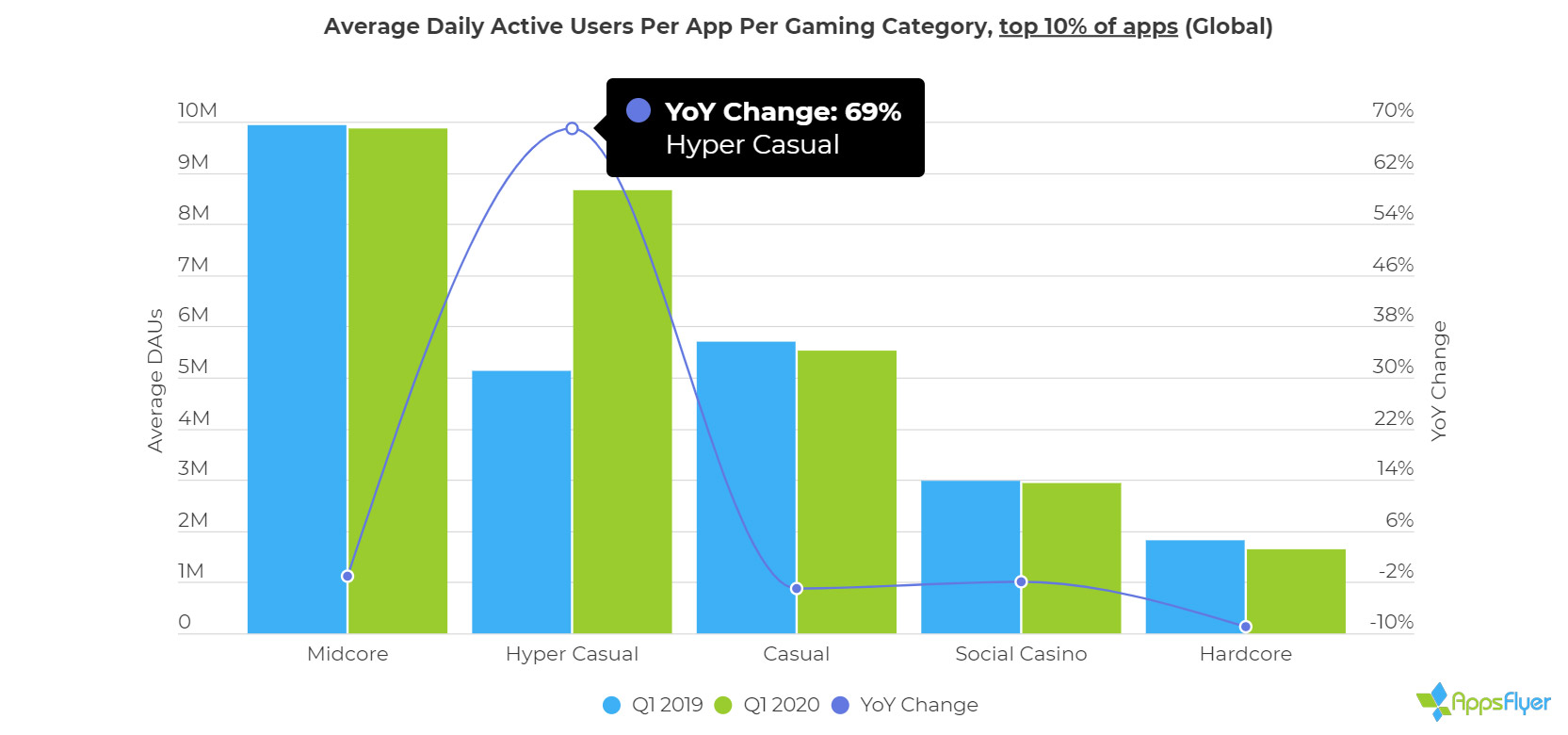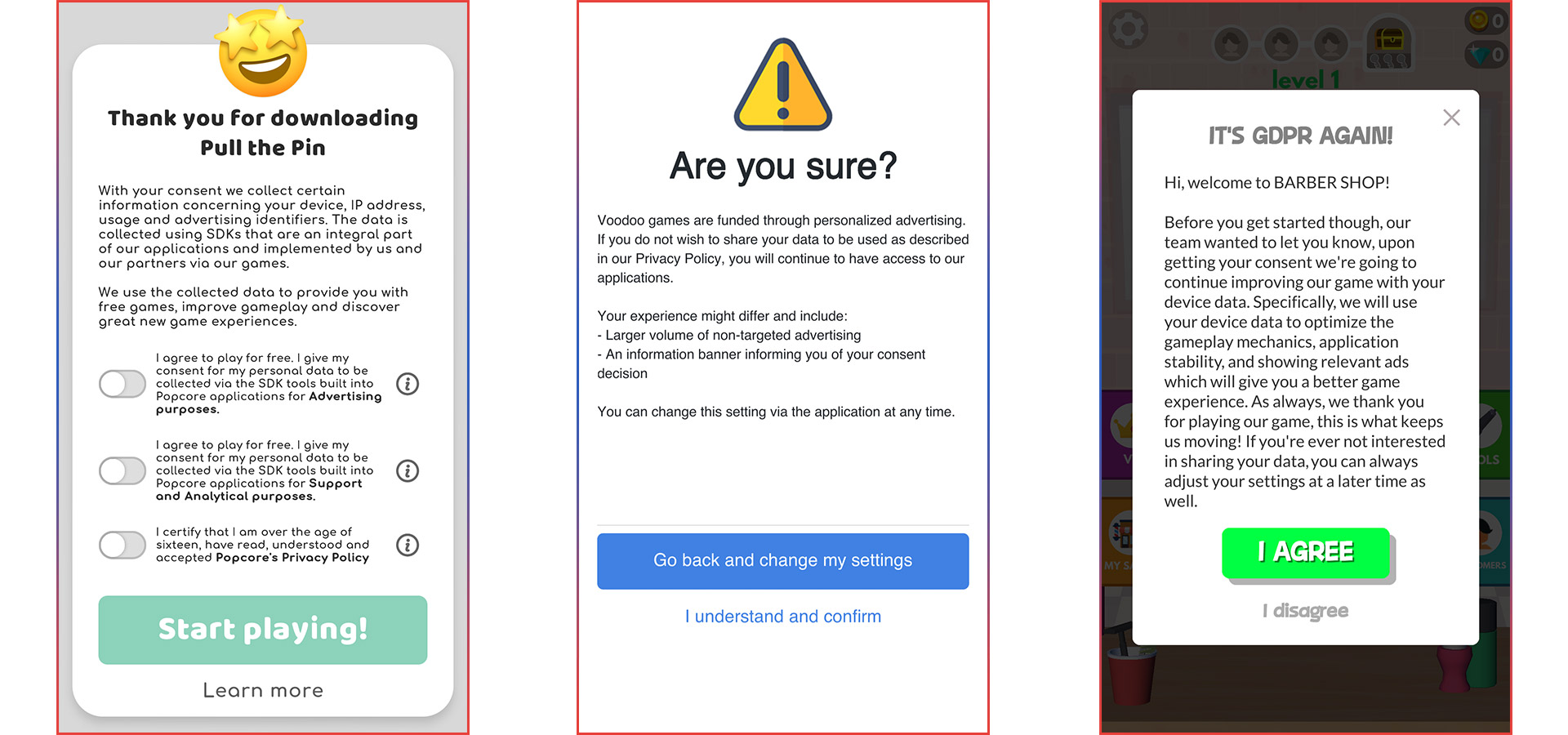It’s no surprise that hyper-casual games dominate the top charts these days. What’s surprising, however, is the sheer volatility of these wildly successful titles.
Hyper-casual games that top the charts today were often virtually unknown a few weeks ago. Likewise, many of these games vanish from the charts just as quickly as they appear. This level of volatility is unheard of in most industries, yet game developers in this space have adapted—and some have even mastered the art of thriving in this fast-paced environment.
At Appodeal, we work with numerous mobile developers who have fully embraced the hyper-casual ecosystem. Unlike other mobile app and game genres, which tend to be more stable, hyper-casual games face immense challenges in getting noticed. However, this volatility also creates opportunities for quick success.
In this article, we’ll explore the key elements that make hyper-casual games successful and what you need to know to make a splash in tomorrow’s top charts.
The Hyper Casual Game Scenario.
The hyper-casual boom began a few years ago but truly skyrocketed during the COVID-19 pandemic. During this period, downloads of hyper-casual games surged by nearly 30% compared to prior timeframes. As we’ve noted before, people sought new forms of entertainment, and mobile games became the go-to choice due to their ease of access.
Between 2018 and 2019, the number of hyper-casual games in app stores grew by an astonishing 170%, while downloads increased by 150%—triple the industry average!
The genre’s rapid evolution, combined with its highly data-driven and iterative business model, has transformed hyper-casual games into a $4 billion industry teeming with opportunities for game developers.

Who plays hyper-casual games?
Hyper-casual games have a broad and diverse audience. With an estimated 650 million players evenly split between men and women, these games cater to a wide range of demographics.
One of the unique aspects of hyper-casual games is their universal appeal. Regardless of age, country, or background, there’s likely a hyper-casual game that connects with each player’s mindset or mood.
Player Migration Between Genres
Hyper-casual games often serve as entry points for players who later transition to more casual or mid-core titles. For instance:
Players of hyper-casual puzzle or sports games might migrate to mid-core games with more robust monetization strategies and higher long-term retention.
Similarly, players of puzzle, arcade, or sports games frequently shift to hyper-casual games for their simplicity and instant gratification.
The genre’s minimal learning curve allows players to jump straight into the action, avoiding complex mechanics, character building, or lengthy tutorials. However, this ease of access also results in higher churn rates. On average, hyper-casual gamers install 10 times more apps than non-hyper-casual players, leading to a rapid rotation of games.
As a result, it’s challenging to identify a "pure" hyper-casual gamer. Many players float between genres, driven by their immediate needs for entertainment or relaxation.
Designing Successful Hyper-Casual Games
Hyper-casual games thrive on capturing attention quickly, delivering fun experiences instantly, and catering to a broad audience. For game developers, mastering this volatile but lucrative genre requires understanding its unique dynamics, leveraging its wide appeal, and staying agile in constant change.
With the right strategy and a solid audience understanding, your hyper-casual game could be the next big hit in the top charts.

Many mobile game developers have the skills to create hyper-casual games, but the real challenge lies in adapting their business models and workflows to produce genuinely successful titles.
You may have heard the phrase, “hyper-casual is not just a genre.” This highlights that creating and monetizing hyper-casual games requires a unique approach, distinct from other mobile game genres. Developers must adjust their games to fit new retention models, engagement features, and monetization strategies.
Key Elements of Hyper-Casual Games
Experienced hyper-casual developers suggest that gameplay sessions should last under one minute. Your game should allow players to enjoy a complete session in moments of downtime—whether waiting in a queue or during a quick commute.
Rather than relying on one-size-fits-all mechanics, successful hyper-casual games evoke specific feelings in players:
- Triumph: Players should feel accomplished with minimal effort.
- Fulfillment: A positive experience at the end of each session is key.
- Show-Off Moments: Gameplays worth sharing on YouTube or social media
Each level should be slightly more challenging than the last, giving users a sense of progression without inducing frustration. Avoid punitive or overly complex mechanics; hyper-casual players value simplicity and instant gratification.
The real challenge lies in building and fine-tuning mechanics to evoke the desired feelings. This process will vary with each title, requiring iteration and data-driven decision-making.
Hyper-Casual Games are ultimately Data-Driven
For game developers who are also players, it can be difficult to separate personal passion from business needs. Falling in love with your creation might hinder your ability to monetize it effectively. Instead, focus on what drives user engagement and conversion rates.
Start With Data
Once you have a prototype, create a short video ad and test it with a small campaign. Track key metrics like:
- Click-Through Rate (CTR)
- Cost Per Install (CPI)
- User Quality
These metrics provide an early indication of your game’s potential success. If your game doesn’t meet specific milestones—each publisher has their own KPIs—iterate on it or even shelve the project and move to the next idea.
Agility Is Key
Success in the hyper-casual market favors developers who can quickly test, refine, and iterate on ideas. Those who are hesitant to move on from non-performing projects may struggle to keep up in this fast-paced industry.

Monetizing Hyper-Casual Games with Success
The most effective way to monetize hyper-casual games is through personalized ads. Players of these games have a higher tolerance for ads and are accustomed to seeing more ads in a single session compared to other genres.
Why Ads Work for Hyper-Casual Games
- Short Sessions: The brief gameplay sessions allow developers to quickly assess and adapt ad strategies.
- High Ad Tolerance: Players are less likely to churn due to frequent ad placements, providing flexibility in monetization.
Optimizing Ad Strategies
- Adjust ad frequency and formats (videos, interstitials, native, etc.) based on user behavior.
- Offer rewards for watching ads, such as in-game currency or bonuses.
- Cross-promote other games under your umbrella to retain players within your ecosystem.
Trends in Hyper-Casual Game Design
A growing trend in hyper-casual games is merging mechanics from multiple genres within a single game. For example:
- Endless Runner + Combat
- Casino + Builder
Sometimes, these mixed mechanics are even present within the same level, providing a dynamic and varied player experience.
Combining mechanics can make balancing ad strategies more complex. Developers must use detailed data to seamlessly integrate ad monetization into the game loop without disrupting gameplay.
The Real Challenge for Developers
The key to monetizing hyper-casual games lies in:
- Leveraging in-depth data.
- Crafting a monetization strategy aligned with your game mechanics.
- Delivering an ad experience tailored to your users.
The ability to innovate, iterate, and adapt will ultimately determine your success in the hyper-casual market. By combining creative gameplay with strategic monetization, developers can unlock the full potential of this lucrative genre.
Ad Monetization aligned with User Retention
Hyper-casual game developers are increasingly integrating ad impression data with in-game user data to create personalized gaming experiences, moving away from treating all players the same.
Why Blend Behavioral and Ad Data?
Combining user behavior and ad impression data provides a key advantage: it enables developers to evaluate whether their ad strategy is offering an enjoyable experience for players. When ads such as banners, interstitials, and rewarded videos are seamlessly integrated into gameplay and mechanics, they not only boost profitability but also improve user retention.
Higher retention rates lead to increased margins and profits, making your game and overall business more sustainable.
Challenges in Balancing Retention and Monetization
Defining global mechanics to improve retention rates in hyper-casual games while maintaining high ad monetization revenue is highly complex.
The Ultra-Casual Trend
Some developers have opted to go in the opposite direction, creating ultra-casual games. These games are simplified to appeal to broader audiences and reduce CPIs (Cost Per Install). However, this often comes at the expense of margins and retention rates, which are very low.
Learning from Other Genres
Conversely, many hyper-casual developers looking to boost retention take cues from adjacent genres, such as casual, idle, match-3, or social games. This involves studying effective retention strategies in these genres and adapting them to hyper-casual games.

To improve 7-day retention rates while maximizing monetization, developers should:
- Study Similar Genres: Learn from the mechanics and strategies that drive engagement in related game genres.
- Create Unique Ad Experiences: Offer personalized and non-intrusive ad experiences tailored to player behavior.
- Balance Ad Monetization with Gameplay: Ensure that ads complement the gameplay rather than disrupting it, enhancing overall user satisfaction
The Keys to Success on Hyper-Casual Games
Each game studio has its unique path to success. However, one common denominator among successful developers is having a reliable monetization partner that provides actionable, high-quality data.
The Role of Monetization Partners
A great monetization partner, like Appodeal, delivers:
- Accurate and transparent data.
- Insights into user behavior, geographical preferences, and cultural nuances.
- Customizable ad solutions that align with user needs.
By leveraging this data, developers can create tailored ad experiences that positively impact monetization and retention rates.
At Appodeal, our goal is to maximize your ad revenue across all ad sources. By partnering with us, you can focus on what you do best: developing games and creating top-earning hits.
Extra: Eager to boost your hyper-casual game?
The hyper-casual genre is growing rapidly, presenting enormous opportunities for developers like you. If you’re preparing to launch a new title, consider exploring the Appodeal Accelerator Program.
Why Join the Accelerator Program?
- Access to large-scale user acquisition campaigns.
- Expert guidance on creating video and playable ads.
- Tailored insights to optimize in-app ad strategies.
We’ll help you determine the best ad frequency, ad formats, and strategies to balance monetization with your game economy and mechanics. By analyzing metrics such as session length and daily sessions, we’ll fine-tune your ad approach to grow revenue and drive the success of your hyper-casual game.
Ready to take your game to the next level? Sign up for free and integrate the Appodeal SDK to start monetizing effectively. Let us handle your monetization while you focus on crafting the next hit in the hyper-casual gaming world!


 Marc Llobet
Marc Llobet